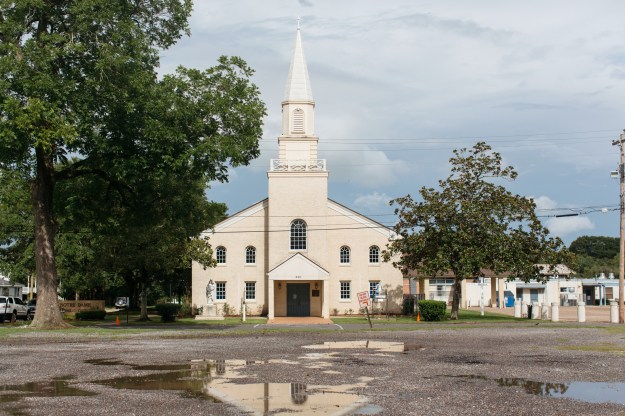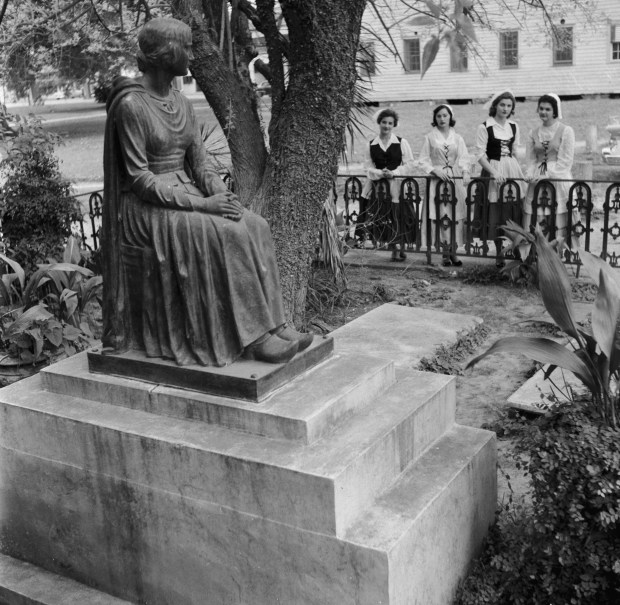On the banks of the Teche are the towns of St. Maur and St. Martin.
There the long-wandering bride shall be given again to her bridegroom,
There the long-absent pastor regain his flock and his sheepfold.
Beautiful is the land, with its prairies and forests of fruit-trees;
Under the feet a garden of flowers, and the bluest of heavens
Bending above, and resting its dome on the walls of the forest.
They who dwell there have named it the Eden of Louisiana.
—Henry Wadsworth Longfellow, “Evangeline: A Tale of Acadie”
It was well past 2 on Christmas morning when my boyfriend, Noah, and I walked to the edge of the Bayou Teche, umbrellas in hand to shield us from the chilly winter mist. Twinkling lights left over from midnight Mass cast a faint glow on the old churchyard, and waves lapped against the riverbank in a steady rhythm. As we stood beneath an old gnarled oak tree, he got down on one knee and asked me to marry him.
This is my fairytale—the one I will tell my children and grandchildren. And it’s no accident that it happened beneath the Evangeline Oak in St. Martinville, La., less than a mile from where I was born and where my ancestors are buried. But it’s not only my roots that are tangled up with this tree. The oak has played a role in countless other fairy tales, real and imagined, and in the process became a touchstone for generations in South Louisiana.
The Evangeline Oak, a nondescript tree two blocks off St. Martinville’s Main Street, is either a romantic talisman or an enchanting tourist trap, depending on the person you speak to.
The tree gets its name from Henry Wadsworth Longfellow’s 1847 poem “Evangeline: A Tale of Acadie,” which chronicles a pair of lovers torn apart after the 1755 British invasion of Nova Scotia in what is now Canada during the French and Indian War. Thousands of predominantly Catholic, French-speaking Acadians were expelled from the region; approximately 3,000, the predecessors of modern-day Cajuns, found refuge in South Louisiana.
Longfellow’s poem left a lasting impact on Louisianian folklore, culture, and oral tradition. The town of St. Martinville christened a shrine to the fictitious star-crossed lovers along the Bayou Teche in the form of a majestic live oak tree.


People go to the Evangeline Oak to throw baby showers, to pose for graduation pictures, and for generations, to wed beneath its branches. When I visited the tree this spring, a handful of leftover purple and silver confetti pieces in the shape of “congrats” and “2018” shimmered against its ancient trunk.
Elaine Clement, St. Martinville’s tourism director, says the tree draws 15,000 to 20,000 people each year. “Some local, but also from all over the world—Australia, France, Canada,” she says, adding that the local justice of the peace performs about two wedding ceremonies a week at the tree.
Clement, a trained historian who admits she once visited the Evangeline Oak on a date in college, says a lot of visitors believe Evangeline was a real woman.
“Evangeline is a purely fictitious character. She is not based on anyone real,” she says. “Longfellow was a Protestant man of British heritage who never visited Louisiana.”
According to In Search of Evangeline: Birth and Evolution of the Evangeline Myth by Louisiana historian Carl A. Brasseaux, the poem has its origins in a dinner party Longfellow hosted in 1844. His friend Nathaniel Hawthorne brought along a clergyman from Maine named H.L. Conolly, who had pitched the idea of a love story set against the Acadian diaspora to Hawthorne but piqued Longfellow’s interest instead.
But Longfellow’s poem doesn’t include any mention of a Louisiana oak tree. “If you read the poem, she only passes through here,” says Clement.
The Evangeline saga didn’t end with Longfellow. It only just began.

In 1888 local writer Sidonie de la Houssaye penned the novel Pouponne et Balthazar, in French, based on Evangeline, setting her tale in St. Martin Parish. Although it was well received by some, others—including a popular local judge—took offense to the way it portrayed Acadians as lower class.
“Her story infuriated Judge [Felix] Voorhies because he had Acadian ancestors,” says Jane Bulliard, a historian in St. Martinville.
In 1907, Voorhies wrote Acadian Reminiscences: The True Story of Evangeline. The story focuses on what he claimed was the true story of Acadian lovers named Emmeline Labiche and Louis Arceneaux, who bear a striking resemblance to Longfellow’s main characters. In Voorhies’ story, the lovers reunite beneath the oak tree, but Louis tells Emmeline he has married someone else. It’s this version of the story that many South Louisianians—including me—thought was true at one point or another. It’s the archetype of Emmeline, not Evangeline, whom our culture has immortalized.
“People take his story to heart and call it the true story of Evangeline,” says Bulliard. “Judge Voorhies didn’t deliberately fabricate. He wrote what he knew. Now we know that’s inaccurate.”
There’s some discrepancy, even in Voorhies’ accounts, as to whether he intended to write something historically accurate (he titled it “The True Story,” after all) or if he used artistic license to create composite characters based on stories passed down through his family.
Brasseaux says he believes the latter. Either way, because so many believed (and still believe) that Emmeline is the real-life Evangeline, out-of-towners continue to report details of the Voorhies story as fact.
Bulliard says that at one point, there was even a movement to return Evangeline’s remains from St. Martinville to her original home in Grand Pré in Nova Scotia. Locals believed that the statue of Evangeline, near St. Martin de Tours church in St. Martinville, marked her grave. (It’s a depiction of Dolores del Rio, the actress who played her in a 1929 film.)
“Somehow the idea got picked up that she was buried here,” says Bulliard. “They wanted her body back, but she’s a nonexistent person.”
Evangeline is particularly complex because it’s a legend with both literary and historical—not to mention cinematic—roots, and it’s all wrapped with the larger origin story of the Cajuns, the narrative that figures today’s Cajuns as yesterday’s Acadians.
“Evangeline is particularly complex because it’s a legend with both literary and historical—not to mention cinematic—roots, and it’s all wrapped with the larger origin story of the Cajuns, the narrative that figures today’s Cajuns as yesterday’s Acadians,” says Joshua Caffery, a local academic who researches Cajun and Creole oral traditions. (Full disclosure: He’s also my brother-in-law). He says the Evangeline/Emmeline story is what folklorists describe as a legend, a story that is told as true, embellished with historical details.
But what is it about “Evangeline” and the tree that makes us want to believe in the connection?
As I walk through the small exhibit at the nearby Acadian Memorial, my finger rests on a glass case showcasing famous people who have Acadian heritage. They include Ellen DeGeneres, Celine Dion, and Beyoncé. I feel my pulse pick up, and even though I know it’s silly, I can’t help feeling a sense of pride wash over me.
My excitement that I might be Beyoncé’s distant cousin dwarfs in comparison to how it must have felt for the 19th-century residents of St. Martinville to have their hometown featured by one of the most famous poets in American history. It gave the Cajuns not only an origin story linked to the Acadian exile but also a sense of importance. In Caffery’s opinion, Longfellow’s “Evangeline” was “instrumental in the formation of Cajun identity.” It’s this identity that, through a rich oral tradition, continues to instill pride in Cajun culture.
But when it comes to the tree, maybe I’m overthinking it. When I ask Bulliard why she believes people keep visiting the Evangeline Oak generations later, she deadpans with a Cajun lilt, “People want to have a place to go. It’s a place, it’s an old tree, and it’s attractive.”
I’m pretty sure that’s why my husband picked it, anyway.